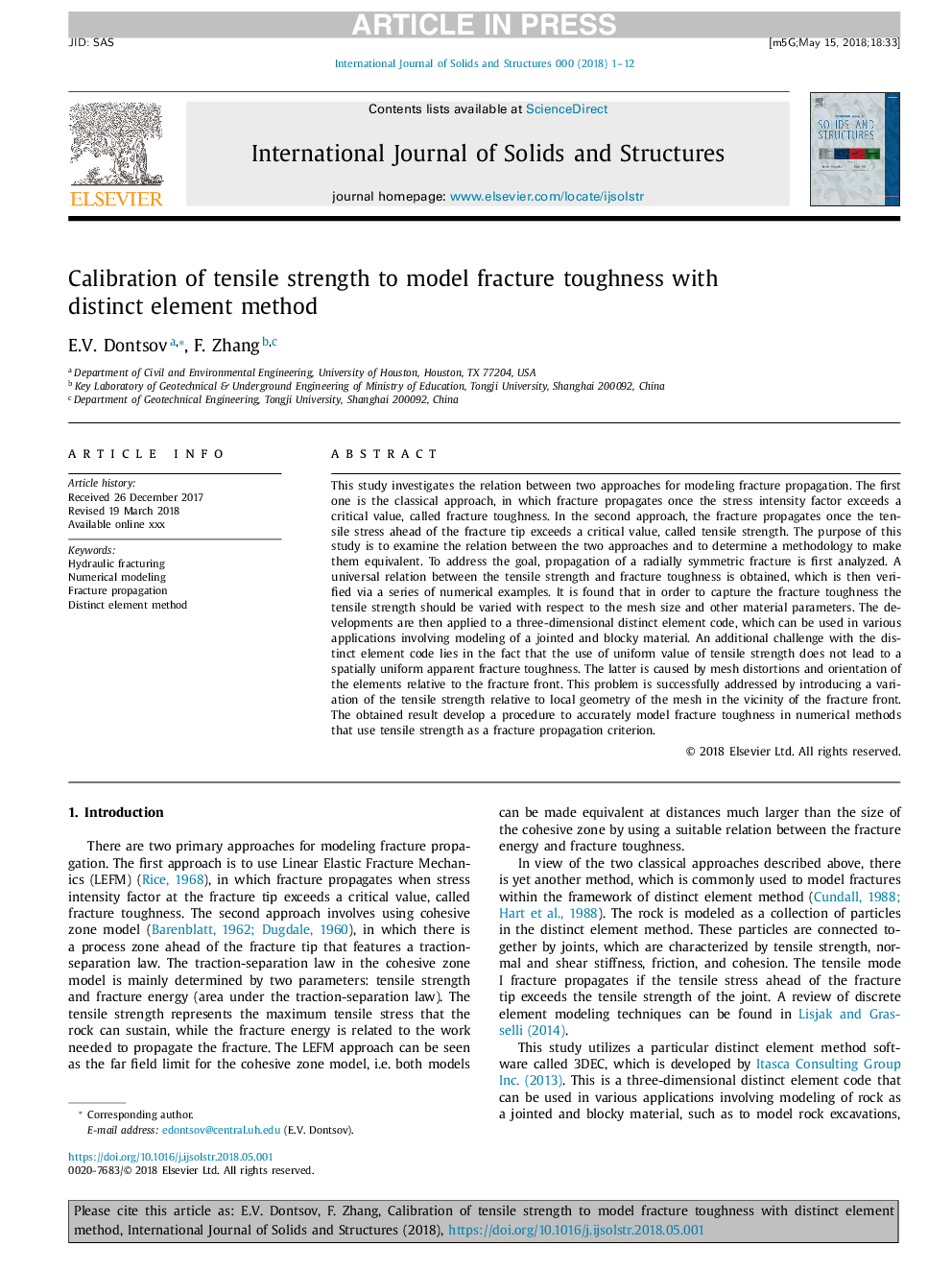| کد مقاله | کد نشریه | سال انتشار | مقاله انگلیسی | نسخه تمام متن |
|---|---|---|---|---|
| 6748272 | 1430166 | 2018 | 12 صفحه PDF | دانلود رایگان |
عنوان انگلیسی مقاله ISI
Calibration of tensile strength to model fracture toughness with distinct element method
ترجمه فارسی عنوان
کالیبراسیون استحکام کششی برای مدلسازی چقرمگی شکست با روش المان مجزا
دانلود مقاله + سفارش ترجمه
دانلود مقاله ISI انگلیسی
رایگان برای ایرانیان
کلمات کلیدی
شکستگی هیدرولیکی، مدل سازی عددی، پخش شکستگی، روش عنصر متمایز
ترجمه چکیده
این تحقیق ارتباط بین دو روش برای مدل سازی شکست شکست را بررسی می کند. اولین روش رویکرد کلاسیک است که در آن شکست فرایند پس از آنکه فاکتور شدت تنفس بیش از یک مقدار بحرانی است، به نام کشش شکست نام برد. در رویکرد دوم شکست پس از آنکه تنش کششی نسبت به نوک شکستگی بیش از یک مقدار بحرانی است، به نام کشش استحکام کشف می شود. هدف از این مطالعه بررسی رابطه بین دو رویکرد و تعیین یک روش برای ایجاد معادل آن است. برای رسیدن به هدف، انتشار یک شکاف شعاعی متقارن ابتدا مورد تجزیه و تحلیل قرار می گیرد. یک رابطه جهانی بین مقاومت کششی و چقرمگی شکستگی به دست می آید که سپس از طریق یک سری از نمونه های عددی تایید می شود. مشخص شده است که برای رسیدن به سختی شکست، استحکام کششی باید با توجه به اندازه مش و دیگر پارامترهای مواد متفاوت باشد. پس از آن، تحولات به یک عنصر عنصر مجزا سه بعدی اعمال می شود که می تواند در برنامه های مختلف شامل مدل سازی مواد متصل و بلوک استفاده شود. یک چالش اضافی با کد عنصر مجزا در این حقیقت است که استفاده از ارزش یکنواخت استحکام کششی منجر به یک چقرمگی شکنی ظاهری یکنواخت نمی شود. دومی ناشی از اعوجاج مش و جهت گیری عناصر نسبت به قسمت شکستگی است. این مسئله با معرفی یک تنوع از قدرت کششی نسبت به هندسه محلی مش در مجاورت جلوی شکست، با موفقیت حل می شود. نتیجه به دست آمده یک روش برای اندازه گیری دقیق چقرمگی شکست در روش های عددی ایجاد می کند که از استحکام کششی به عنوان معیار انتشار شکست استفاده می کنند.
موضوعات مرتبط
مهندسی و علوم پایه
سایر رشته های مهندسی
مهندسی عمران و سازه
چکیده انگلیسی
This study investigates the relation between two approaches for modeling fracture propagation. The first one is the classical approach, in which fracture propagates once the stress intensity factor exceeds a critical value, called fracture toughness. In the second approach, the fracture propagates once the tensile stress ahead of the fracture tip exceeds a critical value, called tensile strength. The purpose of this study is to examine the relation between the two approaches and to determine a methodology to make them equivalent. To address the goal, propagation of a radially symmetric fracture is first analyzed. A universal relation between the tensile strength and fracture toughness is obtained, which is then verified via a series of numerical examples. It is found that in order to capture the fracture toughness the tensile strength should be varied with respect to the mesh size and other material parameters. The developments are then applied to a three-dimensional distinct element code, which can be used in various applications involving modeling of a jointed and blocky material. An additional challenge with the distinct element code lies in the fact that the use of uniform value of tensile strength does not lead to a spatially uniform apparent fracture toughness. The latter is caused by mesh distortions and orientation of the elements relative to the fracture front. This problem is successfully addressed by introducing a variation of the tensile strength relative to local geometry of the mesh in the vicinity of the fracture front. The obtained result develop a procedure to accurately model fracture toughness in numerical methods that use tensile strength as a fracture propagation criterion.
ناشر
Database: Elsevier - ScienceDirect (ساینس دایرکت)
Journal: International Journal of Solids and Structures - Volumes 144â145, July 2018, Pages 180-191
Journal: International Journal of Solids and Structures - Volumes 144â145, July 2018, Pages 180-191
نویسندگان
E.V. Dontsov, F. Zhang,
